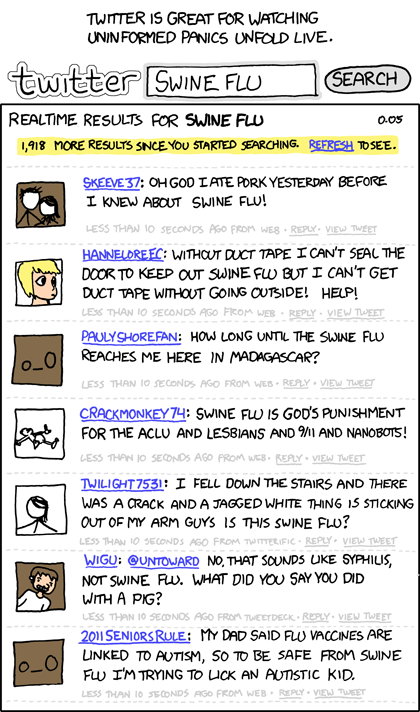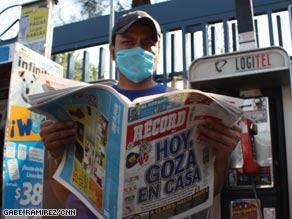So XKCD posted this yesterday ……

Now CNN made this post http://www.cnn.com/2009/TECH/04/27/swine.flu.twitter/index.html
(CNN) — The swine flu outbreak is spawning debate about how people get information during health emergencies — especially at a time when news sources are becoming less centralized.

Buzz about swine flu on Twitter is stirring conversations about how people get health news.
Some observers say Twitter — a micro-blogging site where users post 140-character messages — has become a hotbed of unnecessary hype and misinformation about the outbreak, which is thought to have claimed more than 100 lives in Mexico.
“This is a good example of why [Twitter is] headed in that wrong direction, because it’s just propagating fear amongst people as opposed to seeking actual solutions or key information,” said Brennon Slattery, a contributing writer for PC World. “The swine flu thing came really at the crux of a media revolution.”
Twitter’s popularity has exploded in recent months, and Slattery said it’s a new development that a wide number of people would turn to the site in search of information during an emergency.
Others take a softer approach to the buzz on Twitter.
Writing for CNET, a CNN partner site, Larry Magid advises online readers to take medical advice with a grain of salt.
The Internet is “a great way to get general information, prevention tips and information on how to handle a known condition, but be cautious when using it to try to diagnose yourself,”he writes.
Several dozen cases of swine flu worldwide have been confirmed by the World Health Organization and hundreds more are feared. Read more about the situation
That information needs to be put in context by journalists, especially given the fact that so many deaths from the common flu occur each year and go underreported by the news media, said Al Tompkins, who teaches broadcast and online news at the Poynter Institute, a school for journalists.
About 36,000 people die from flu-related symptoms each year in the United States, according to the Centers for Disease Control and Prevention,
The fast pace of new swine flu cases and their relevance to global public health policy makes the situation newsworthy, Tompkins said.
Tompkins said there is a tendency for television stations to hype health emergencies to boost their ratings, but so far coverage of the swine flu outbreak has been responsible. Coverage of the story is just ramping up, though, he said.
Of the swine flu news on Twitter, Tompkins said, “Bad news always travels faster than good news. I’m sure that was true in smoke signal days.”
Unofficial swine flu information on Twitter may lead people to unwise decisions, said Evgeny Morozov, a fellow at the Open Society Institute and a blogger on ForeignPolicy.com.
For example, some Twitter users told their followers to stop eating pork, he said. Health officials have not advised that precaution. Read about how the virus is transmitted
Morozov said there’s incentive for Twitter users to post whatever is on their mind because it helps them grow their online audiences.
But in an emergency, that tendency means people write about their own fears of symptoms and widespread deaths, which can create an uninformed hysteria, he said.
The debate about swine flu on Twitter is not one-sided, however. And the site is not the only place online where people are talking about the outbreak.
Some Twitter users have expressed concern that the swine flu story is being hyped. Several media outlets, including the BBC and CNN’s iReport.com, give readers and viewers a chance to express their own views about the outbreak.
The Centers for Disease Control and Prevention also maintains its own Twitter account where official government information is given straight to the public.
And on Monday, President Obama seemed to try to calm national fears by saying the outbreak is “cause for concern and requires a heightened state of alert,” but is not a “cause for alarm,” CNN reported.
Twitter traffic about swine flu has been strong. According to Nielsen Online, swine flu has worked its way into about 2 percent of all notes posted on the site on Monday. You can follow that Twitter conversation here.
Chatter about swine flu is also loud elsewhere online. About 10 times more people are writing online about swine flu than wrote about the salmonella and peanut butter scares from this winter, Nielsen says.
On Google, an interactive map lets Internet users see where outbreak deaths have been confirmed and where they are suspected. See a CNN map
Slattery, the PC World writer, said he generally was excited about Twitter until recently. Now he finds the site to be “an incredibly unreliable source of information.”
Tompkins said people who post information on social media sites should think about the credibility of their sources before they pass something on.
That’s the “online equivalent of washing your hands,” he said.
“Before you pass it on, wash your hands a little.”
And yes i did bold the “About 36,000 people die from flu-related symptoms each year in the United States, according to the Centers for Disease Control and Prevention” , as I think its fairly relevant to the panicdemic about swineflu. It only has a 4% or less hit rate. Though we have lots of ways to get it around the world really fast, we also have a LOT better ways of dealing with it and medicines and other similar things than say the previous pandemics that the world has seen.
So if I were you, i wouldnt panic just yet. Thank god its not something else, Bird flu fatality rate was 60%, SARS was 9.6% (though these figures probably vary depending on the countries socio-economic development as well as many other factors) – and they havn’t and wont rule out Bird flu, its a matter of time rather than ‘you said it was coming and it never did’.
